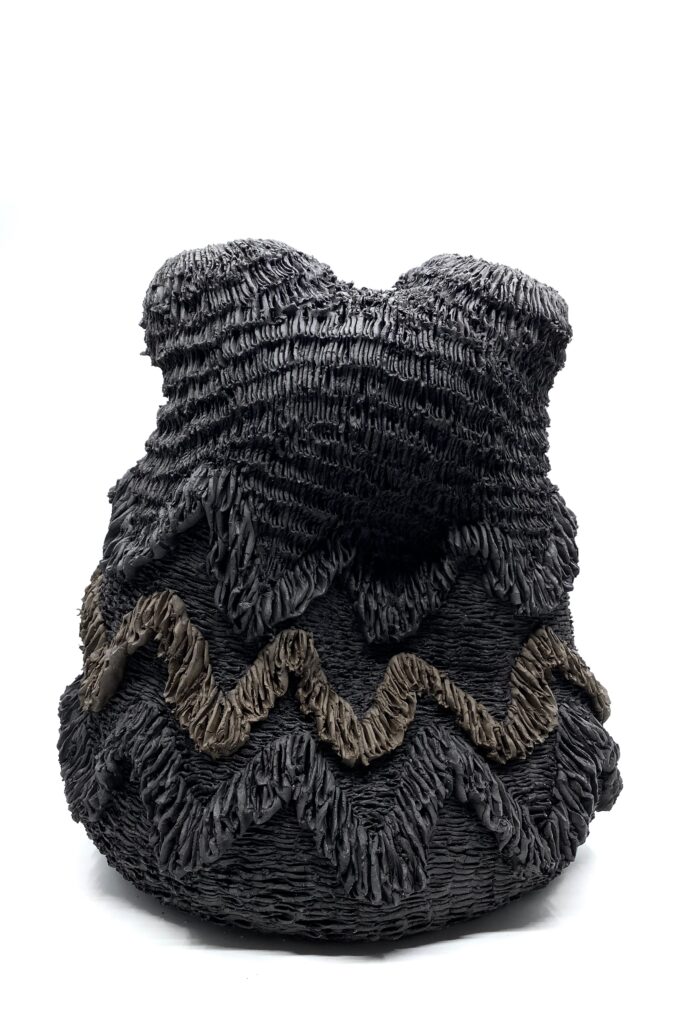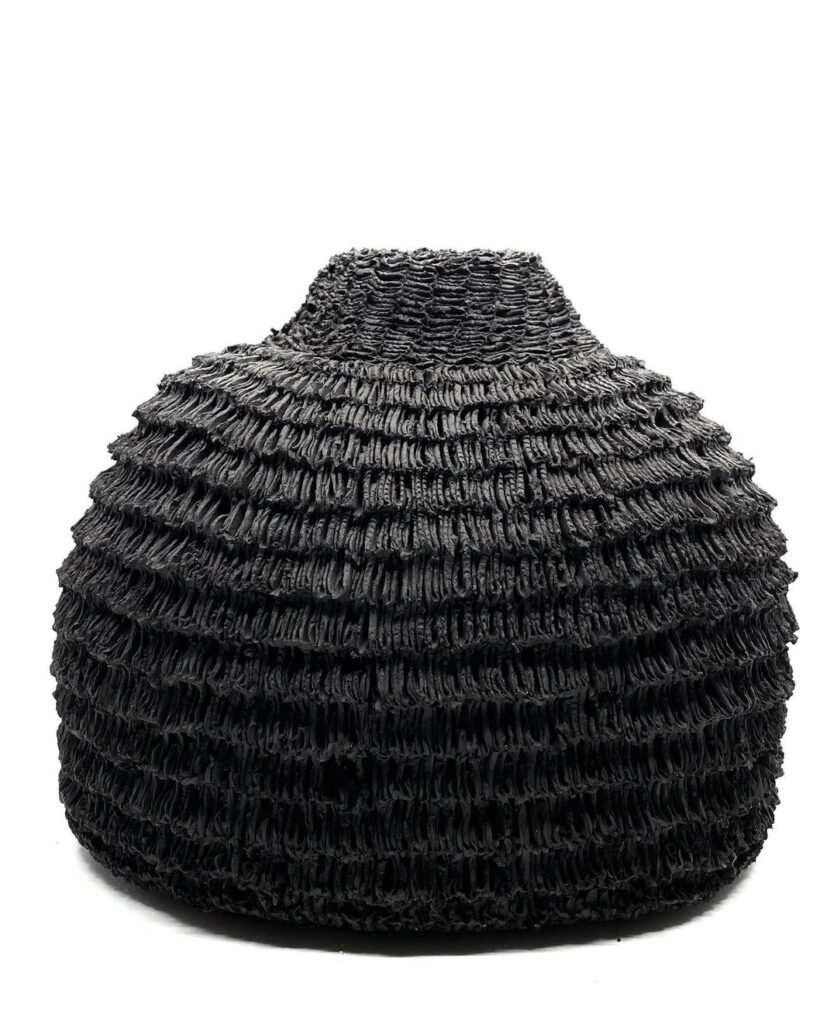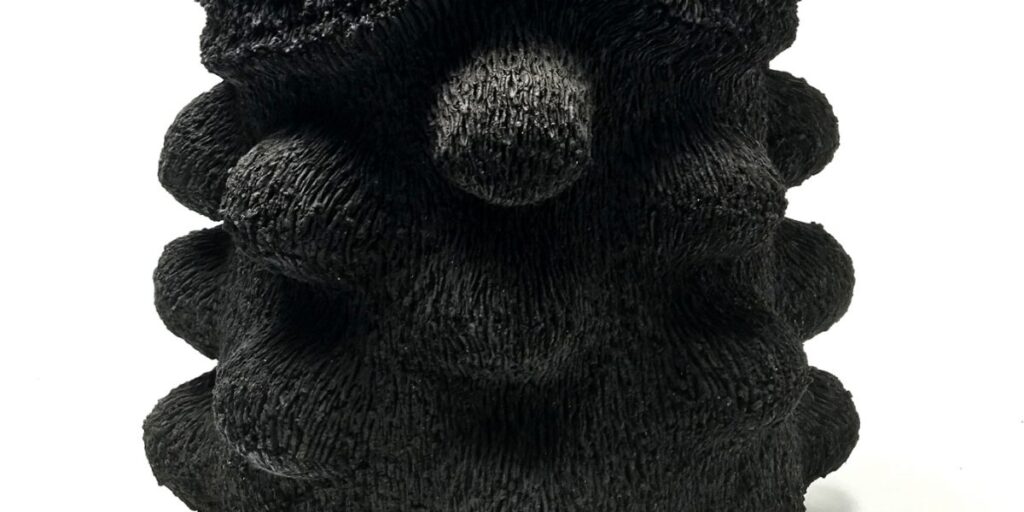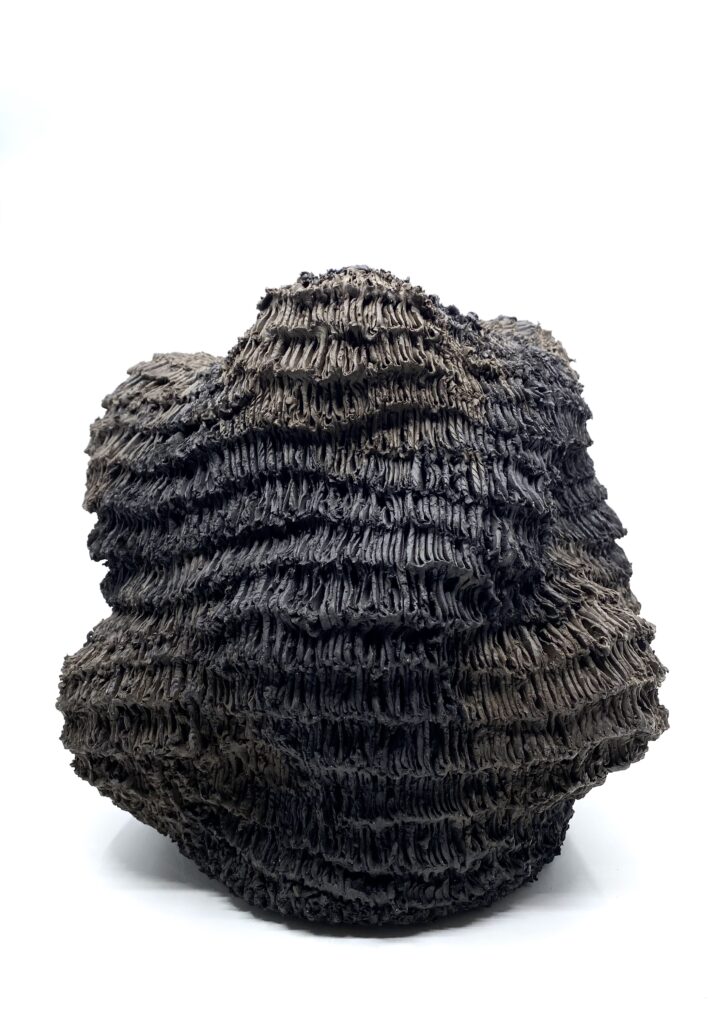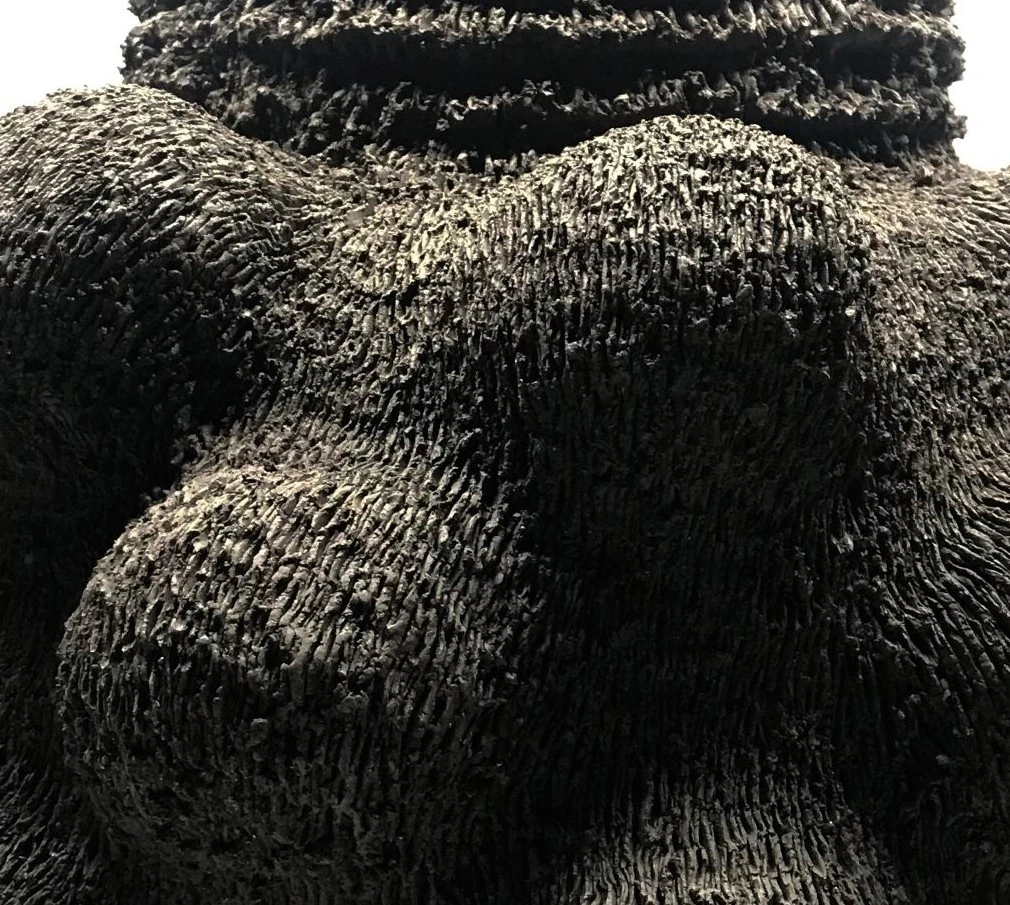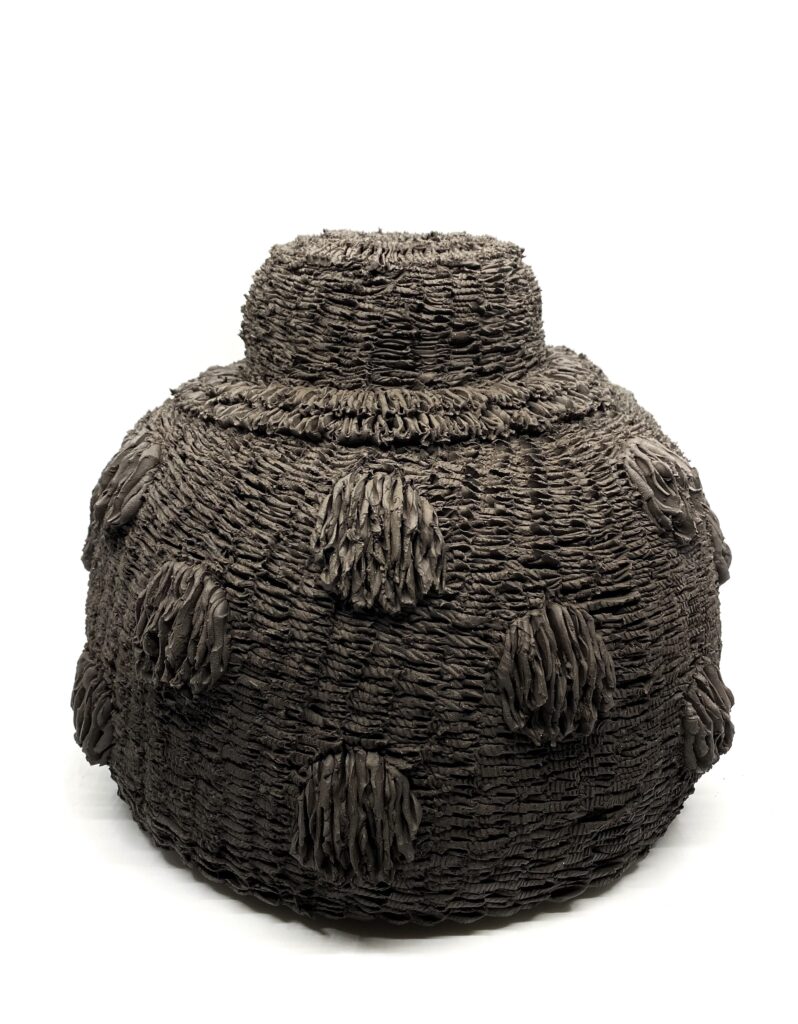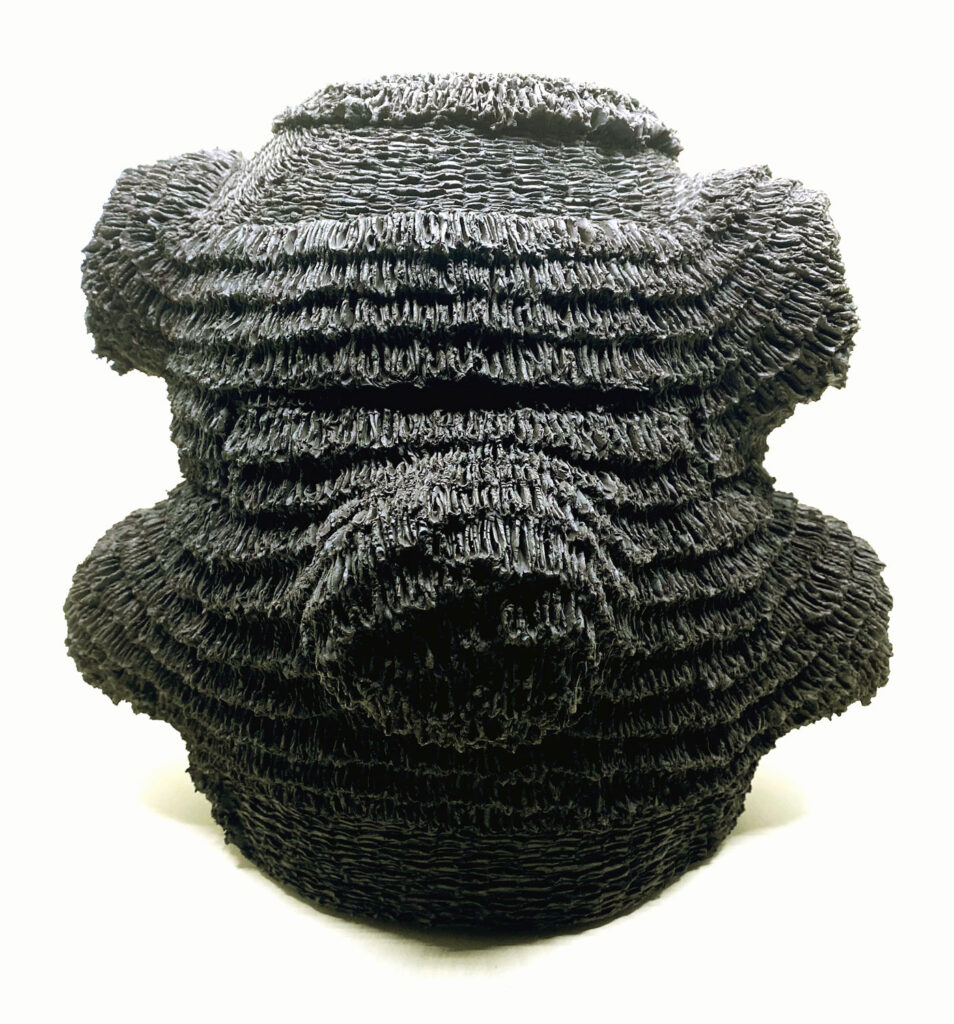
Ceramic artist Donté Hayes was born in Baltimore in 1975. He now lives and works in New Jersey, USA.
Recently showcased at 25th San Angelo National Ceramic Competition, Toronto Canada, 2024, Newcomb Art Museum, New Orleans, 2024 and Design Miami Art Fair, Miami, 2023
interview with ceramic artist DONTÉ HAYES
Born in Baltimore (USA) in 1975, Donté Hayes creates vessels that re-establish forgotten histories from beyond the typical canon of art history. Having studied printmaking at Kennesaw State University, Georgia, Hayes later turned his attention to clay in 2017. He recognised the material’s soft malleability as a collector of memory, as it captures the history of mark and touch. These are therefore not simply vessels, they are vessels of resonance, echoing histories forgotten, or perhaps histories never once recognised. The power of sculpture lies in its materiality: its occupation of space demands a multifaceted engagement, ensuring a dynamic interaction with a viewer. Such a premise is vital to the realisation of Hayes’ vessel of resonance. Drawing on his printmaking and etching expertise, Hayes wields a fine needle to stitch delicate threads of clay into rhythmic undulations that ripple across the surfaces of his works. Each layer, infused with the memory of his touch, exudes a tactile allure that entices viewers to trace the contours with their fingers, irresistibly drawn to explore the material’s form and essence. ‘This is our natural human inclination,’ Hayes points out. ‘These objects have a vibration, they make you feel something regardless of why I made them. You know why? Because I’m human. And so are you.’ We are pulled in to connect with these objects, to understand the maker’s mark – but to what ends? Hayes, an avid historian and dedicated researcher, immerses himself in the overlooked narratives of his lineage and that of fellow African Americans. Disheartened by the disconnect between established Western histories and that of his own heritage, Hayes channels his discoveries into his ceramic art, aiming to revive the forgotten past of much of the African diaspora. Tracing his ancestry to Ghana and Burkina Faso, he explores the lives of those whose stories were diminished to mere footnotes in the transatlantic slave trade. He seeks to understand: what were their rituals? What ceremonies did they hold sacred? What were their objects of resonance? These inquiries, combined with months of research, inspire Hayes to create vessels that embody the synergy of ancestral history and our modern understanding. The undulating layers of sewn clay, for example, recall the thatched roofs of a West African home, while the rich black porcelain induces a sense of strength revered in this culture yet marginalised in Western narratives, where white porcelain is prized as pure and refined. As a result, a line of interconnectivity is enacted: rituals of the past are evoked in the rituals of today as we the viewer are beckoned to interact with these objects, seeking to understand their history and their power of resonance.
How long have you been working with clay?
I started working in clay in 2014 while enrolled in a ceramics class during my time as an undergraduate student studying Printmaking and Drawing at Kennesaw University in Kennesaw, Georgia, USA. Ironically, I only enrolled in the ceramic class to pass the three-dimensional requirements to receive a Bachelor of Fine Arts Degree in Printmaking and Drawing.
How would you define clay and your relationship to it?
I see my relationship with clay as a partnership of understanding and permitting the medium to guide where my research, interest and thoughts intersect. Clay is a beautiful material and can be at its most illuminating when the clay itself becomes content.
Which artists, either contemporary and historical, have had an impact on you over time?
The artist that continues to impact me as an artist and person is Elizabeth Catlett. Elizabeth was one of three students to earn the first Masters of Fine Arts Degree at the University of Iowa, USA, as well as one of the first people and first women of African descent to graduate with a Master of Fine Arts (MFA) degree in the entire United States in 1940. Elizabeth Catlett inspired me to follow in her footsteps in attending and graduating with my MFA from the University of Iowa in 2020. Catlett was a printmaker and sculptor who used her art to document and show the beauty and excellence of the people of the African Diaspora while also being the voice to the voiceless and marginalised in society. From Elizabeth Catlett’s example, I strive to make work that is not just aesthetically beautiful but also uplifts and confronts the viewer to see the humanity in all of society.
What other influences have seeped into your work during your career?
My artwork is informed by researching traditional West African heirlooms and initiation rites of birth, adulthood, marriage, eldership and ancestry which are essential to all human growth and speaks to the greater African Diaspora. Along with my interest in history, my work is additionally influenced by science-fiction, comic books, and hip-hop culture.
Are there any traditional threads that exist in your practice? If so, what are they?
Before I started working in clay, my primary medium of choice was printmaking and drawing. The transition from working in print to working in clay has been very seamless due to the many similarities that exists in both mediums. I consider my sculptures as three-dimensional prints. Akin to mark-making with an etching tool on a metal plate in printmaking, I use the potter’s needle tool to create individual marks on the surface of the clay with each strand becoming a collective form.
Can you explain your process of making?
The process of making my work comes in three stages with the first being conducting research, then the actual physical creation of the artwork and finally documenting and naming each piece of art. Each process is a separate entity and they never overlap or are completed at the same time. The research phase is the longest process. I usually research nine months out of the year with the remaining three months to create, document and title works. I see research to mean many things, from reading historical books, watching documentaries, bingeing on trashy television, to writing, reading comic books, listening to music or a podcast, to cooking and having a nice walk with my wife. In order to make authentic art you must have an authentic life. I never make sketches or draw out any of my forms before I begin sculpting. I want the clay, the repetition of the mark-making, the research and my thoughts to intuitively move the creative process forward. I always listen to hip-hop music or have a movie that I have seen numerous times before playing in the background, like Star Wars, Harry Potter, and Star Trek. I become one with the clay material in a ritualistic transcendental experience where time and space stops. I make each sculptural form one at a time. I do not stop until the sculpture is finished. I don’t get up to eat or drink. It is powerful how the body and the mind can slow down when we choose to be present.
What role does experimentation play in your artistic practice?
Experimentation plays a large role in my practice. I do not come with any pre-conceived ideas or drawings and sketches during the creative phase in making my artwork. So, experimentation, spontaneity and trusting that the clay and your experience will take you on the right path is very exciting. I never view not knowing how the finish sculpture will turn out as something to be scared of but as an opportunity to initiate something powerful that will impact how you see yourself and the world around you.
What role does colour play in your work?
The role of colour plays an important role because the artworks are monochromatic abstract sculptures. Furthermore, the forms are heavily textured, and this then allows the viewer to focus on the movement of the form. I want the form and texture to enhance one another. The clay material is the content allowing the viewer to bring their own history and experiences to the artwork. The ceramic sculptures are not glazed because of I don’t want the glaze to overpower or distort the texture. In many of the works, I use a black clay body that when in a wet and unfired state is dark brown in colour. The clay only turns black once fired to its temperature of maturity. I can manipulate the range of how saturated the black colour is through adding or subtracting black mason stain during the mixing of the clay before it is formed into a sculpture. I want the beauty of the clay to speak for itself. The African Diaspora is vast and is not monoliphic with a range of colour variety to black people throughout the world. I also use porcelain for its white colour and for its inherent content and ceramic history. I compare the life and death of coral to the life and death of black people. Coral when alive is colourful, and bright but when is dead it is bleached and white. During the Atlantic Slave trade, some Africans were thrown overboard to die and have their resting place be in the Atlantic Ocean with the coral. They were once vibrant beautiful people with hopes and dreams but now that bright light is no more they are like the dead white coral at the bottom of the sea. It also speaks to the present day and how society only sees the humanity of black people though their death and not their entire breath of life. Lastly, I am responding to how western art canon views porcelain as a more valuable pristine material when discussing the ceramic arts. I view these abstract ceramic sculptures as vessels in illuminating the beauty, intelligence, and excellence of the African Diaspora and that blackness has contributed to the enlightenment of all humanity.
Would you say your work is charged with emotion – If so, which emotions and do you think the viewer might be able to feel them?
I feel that my work is charged with all the emotions that come along with being a human being. I am not trying to create a certain emotion; I am just being authentic. Once another person views the work, it is no longer about me but what they perceive. You bring yourself to the work and whatever you discern is the emotion it brings, regardless of my intention or not.
What are some of the core themes/concepts that you explore in your ceramic work, and why are they important to you?
From elementary through graduate school, when the content of the class was on the enslavement of people of African descent, the teacher would omit what region or country in Africa they were taken from. Africa is a continent, not a country. I was left with even more questions about my ancestors: did they have kings, queens, what kind of food did they eat, clothes did they wear, housing did they have, rituals and celebrations did they participate in, what kind of art did they make? How come I didn’t know them as human beings with lives and histories? How come I only knew them as enslaved? Through my work I am seeking lost, erased or undiscovered knowledge, a past that no one knows or was taught in school. I learned all this knowledge through my own research and asking questions. Learning the past is a way to understand the present. Artifacts are a tangible history which have the capacity to retain, transform, destroy, erase and evoke lost knowledge. I am constructing future artifacts for the purpose of creating new interpretations and connections with ceramic material, history and social-political issues. These new artifacts preserve, empower and document the past and present to initiate healing and understanding for the future.
What is your perception of the recent surge in interest in ceramic art?
As I mentioned before, I didn’t come into working in clay because of any preconceived notions of this material. However, I found the joy in working in clay on my own terms without any consideration of the art world’s view of ceramics. Clay presents me with an opportunity to make work that is universal. Clay is malleable, we can touch it, hold it, be one with it. As human beings we all strive to have meaningful relationships connecting us to each other. We know the history of humanity through the ceramics that have been left behind. So regardless of interest in the material, it’s not going anywhere. Ceramics is a part of human existence and will always be appreciated.
‘These objects have a vibration, they make you feel something regardless of why I made them.
You know why?
Because I’m human.
And so are you.’
.
[Donté Hayes in conversation with Art Formes]


